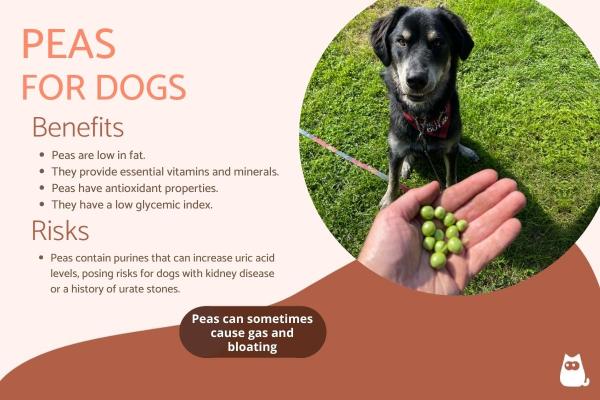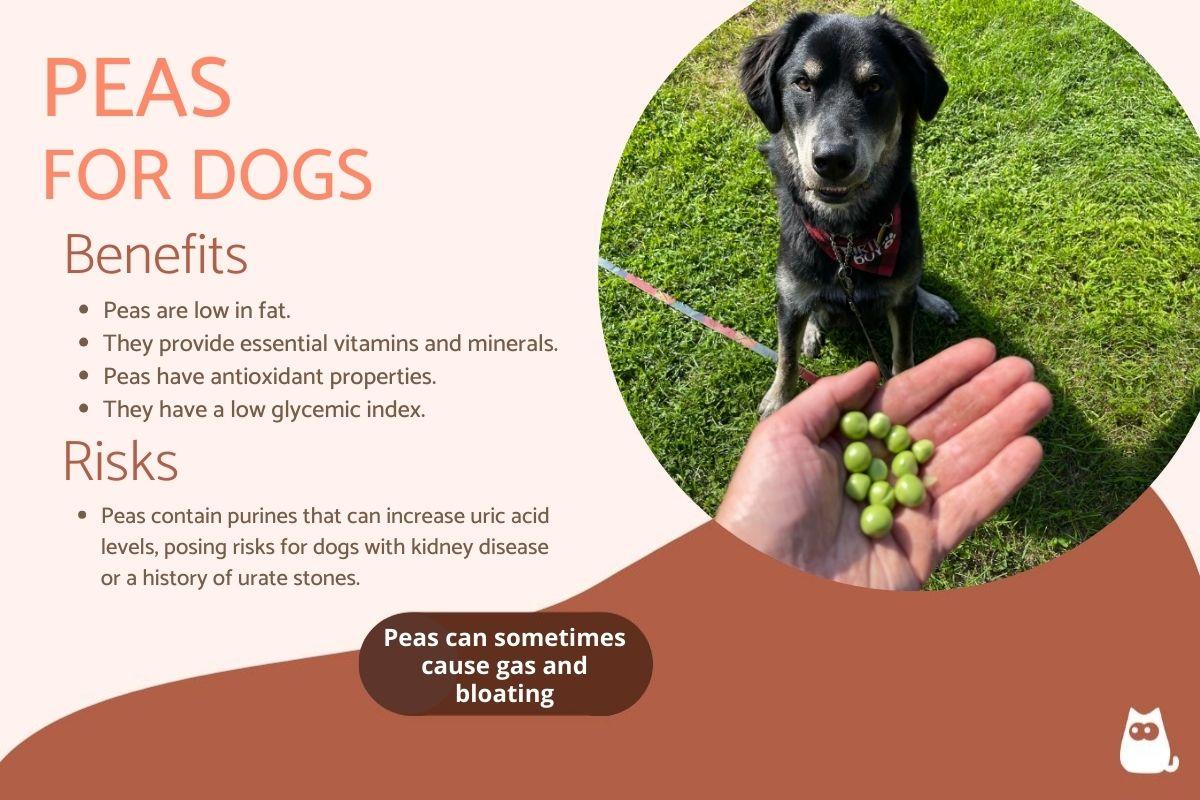Are Peas Good for Dogs?



See files for Dogs
When it comes to choosing healthy snacks for your dog, peas may not be the first thing that comes to mind, but these little green veggies actually are very nutritious. Rich in vitamins, minerals, and fiber, peas can be a great addition to your dog's diet—if served correctly. However, while peas offer many health benefits, there are also potential risks and contraindications to be aware of, particularly for dogs with certain health conditions.
In this article, we’ll explore if peas are good for dogs, the nutritional benefits, the best ways to serve them, and how to ensure they complement your dog’s overall diet.
Can dogs eat peas?
Yes, peas are generally safe and healthy for dogs when fed in moderation.
They are a common ingredient in many commercial dog foods due to their rich nutritional profile.
However, it's essential to avoid feeding canned peas, as they often contain high levels of sodium, which can be harmful to dogs. Stick to fresh, frozen, or steamed peas, served plain without added salt, butter, or other seasonings.
While peas can be a nutritious addition to your dog's diet, it's important to introduce them slowly to prevent digestive issues like gas or diarrhea, and they should only make up about 10% of your dog's overall caloric intake.
Benefits of peas for dogs
As mentioned earlier, peas are not only a legume suitable for dogs, but they also offer several nutritional benefits. Here are some of the most important health benefits of including peas in a dog's diet:
- Rich source of protein: while it may seem surprising, peas provide a substantial amount of plant-based protein. In fact, an average serving of peas contains almost as much protein as an egg. Although this is a vegetable-based protein, it includes essential amino acids that dogs require but cannot synthesize on their own. Notably, peas provide leucine, lysine, phenylalanine, and arginine, which are crucial for muscle maintenance and overall health
- High fiber content: peas are an excellent source of dietary fiber, which, although indigestible by dogs, plays a vital role in maintaining healthy digestion. Fiber helps regulate intestinal transit, aids in managing food intake, and supports the beneficial gut microbiota, contributing to overall gut health.
- Low fat content: peas are low in fat, containing only 0.4 grams of fat per 100 grams, making them a low-calorie addition to a dog’s diet. Their energy mainly comes from carbohydrates and proteins, making peas suitable for dogs needing a balanced diet or weight management.
- Mineral-rich: peas are packed with essential minerals like phosphorus, iron, potassium, and magnesium. These minerals play important roles in bone health, oxygen transport, and overall cellular function.
- Vitamins: peas are particularly rich in B vitamins, including B1 (thiamine), B3 (niacin), and B9 (folic acid). They also contain vitamin C, although most of it is lost during cooking. These vitamins contribute to energy production, nervous system health, and immune function.
- Antioxidants: peas contain beta-carotene and other carotenoids, such as lutein and zeaxanthin. These compounds are antioxidants that help support vision, skin health, and protection against cellular damage.
Don’t miss this other article where we discuss the best fruits and vegetables you can safely offer your dog.
How do I feed my dog peas?
When adding peas to your dog’s commercial food, it’s best to offer them as an occasional treat or reward. Since peas are low in calories yet rich in protein and fiber, they make a nutritious snack. However, it's important to ensure that peas make up no more than 10% of your dog’s daily caloric intake to avoid potential digestive issues. On the other hand, if your dog follows a homemade diet, peas can be included more regularly. Just be sure to combine them with other nutrient-rich foods like meat, grains, or healthy fats to ensure a balanced meal. This way, your dog will receive adequate amounts of protein, vitamins, and minerals for optimal health.
While dogs can eat raw peas, cooked peas are easier for them to digest. Cooking helps break down the peas’ proteins and carbohydrates, making them more digestible. Steaming is the best method as it preserves more nutrients, like B vitamins and antioxidants, compared to boiling. However, boiling peas is still acceptable if steaming isn't an option.
Fresh peas are the best option, especially when they are in season, as they retain the most nutrients. If fresh peas aren’t available, frozen peas are a great alternative, but they should always be cooked before serving to ensure they’re safe and easier for your dog to digest. In contrast, canned peas should generally be avoided due to their high sodium content, which can be harmful to dogs. If you must use canned peas, make sure to rinse them thoroughly to remove excess salt and any harmful additives. Regardless of the type of peas you choose, always serve them plain—without any added salt, butter, or spices. You can steam peas and offer them as a snack, mix them into your dog’s regular meals, or mash them if your dog has trouble chewing or swallowing. This ensures your dog gets the benefits without unnecessary risks.

Dosage of peas for dogs
If you choose to offer peas as a treat, keep them as an occasional indulgence, providing them once a week or every other week. The amount should be tailored to your dog's size: small dogs (4-7 peas), medium dogs (8-10 peas), and large dogs (10-12 peas). To prevent overfeeding, peas should constitute a small portion of their overall treat intake.
If you'd like to incorporate peas into your dog's daily diet, the amount should be determined by their individual energy and nutritional requirements, considering factors like age, weight, and activity level. To ensure a balanced diet that meets your dog's specific needs, consult with a veterinarian, ideally one specializing in animal nutrition. They can help you determine the appropriate proportions of protein, carbohydrates, fats, and essential micronutrients.
Side effects of peas for dogs
Peas are not harmful to dogs when fed in moderation, but providing them improperly or in excessive amounts can lead to undesirable effects:
- Gas and digestive issues: legumes, including peas, contain fiber and certain carbohydrates (oligosaccharides) that can be hard for dogs to digest, especially if they’re not used to them. Excessive peas can cause gas, bloating, or even diarrhea in dogs.
- Nutritional imbalance: when peas are overfed or not properly balanced with other nutrients, it can disrupt the overall nutrition of a dog's diet. If peas make up too large a portion of the meal without being combined with adequate protein, fat, and other essential nutrients, it may lead to deficiencies or imbalances in the long term.
- Kidney issues: peas contain purines, which are compounds that break down into uric acid. In dogs with pre-existing kidney problems or those prone to conditions like kidney stones or urinary issues, excessive uric acid can be problematic. High levels of purines can increase the risk of developing kidney stones or aggravating existing kidney conditions.
- Allergic reactions: while rare, some dogs can be allergic to peas or legumes. Signs of an allergic reaction could include itching, skin rashes, ear infections, or gastrointestinal problems like vomiting and diarrhea.
Be sure to read this other article on fruits and vegetables you should not give to your dog.
If you want to read similar articles to Are Peas Good for Dogs?, we recommend you visit our Homemade diets category.
- Ministry of Agriculture, Fisheries and Food (MAPA). Pea. Pisum sativum. Available at: https://www.mapa.gob.es/es/ministerio/servicios/informacion/guisante_tcm30-102701.pdf






